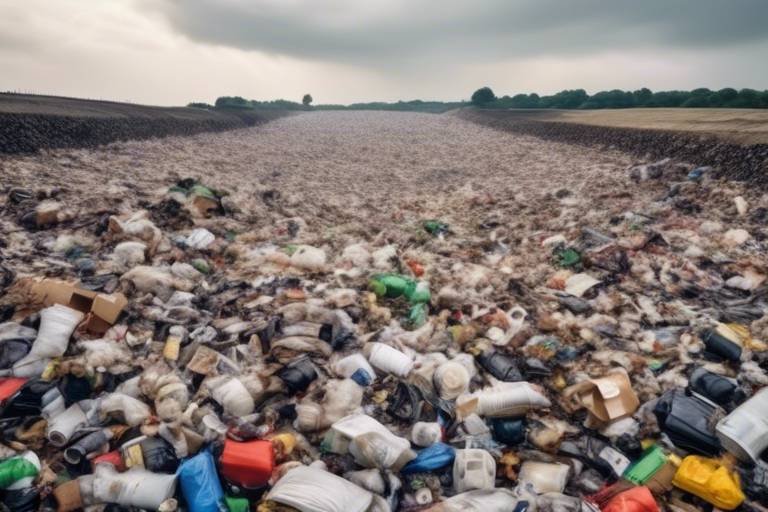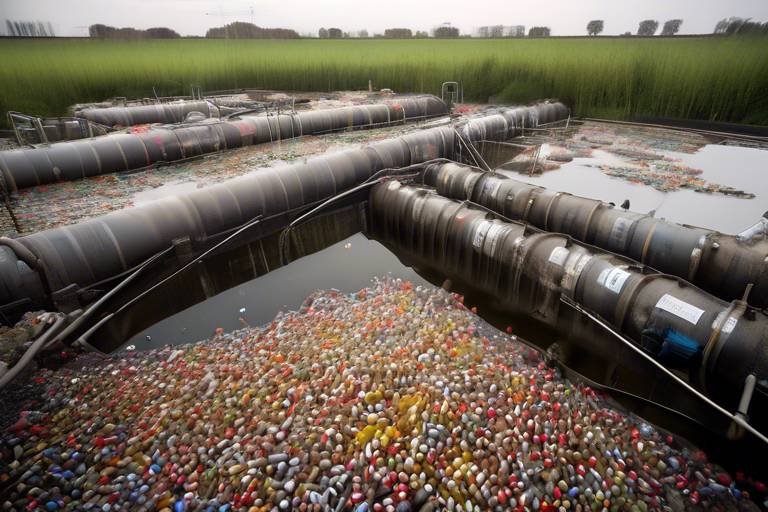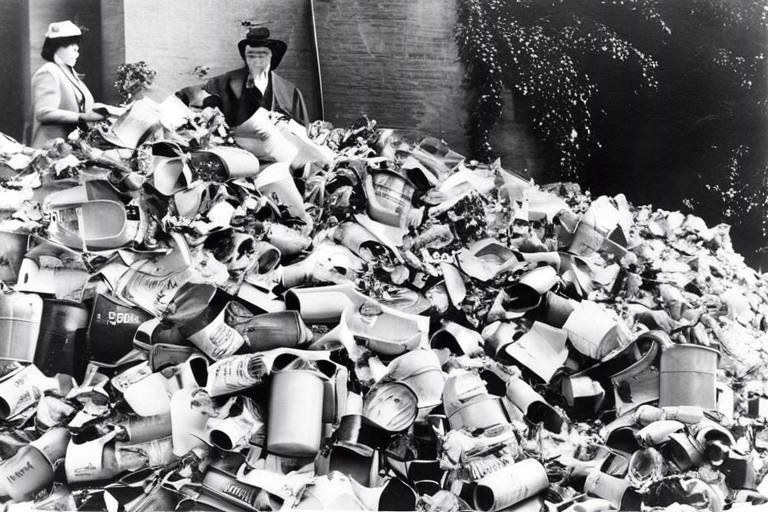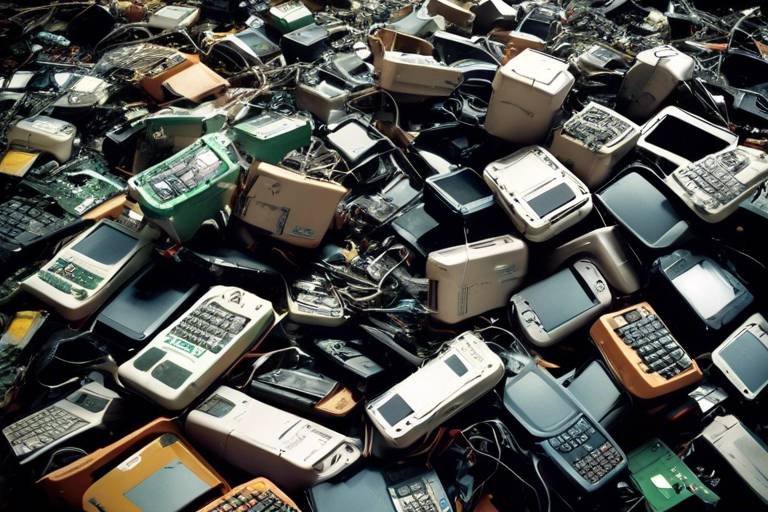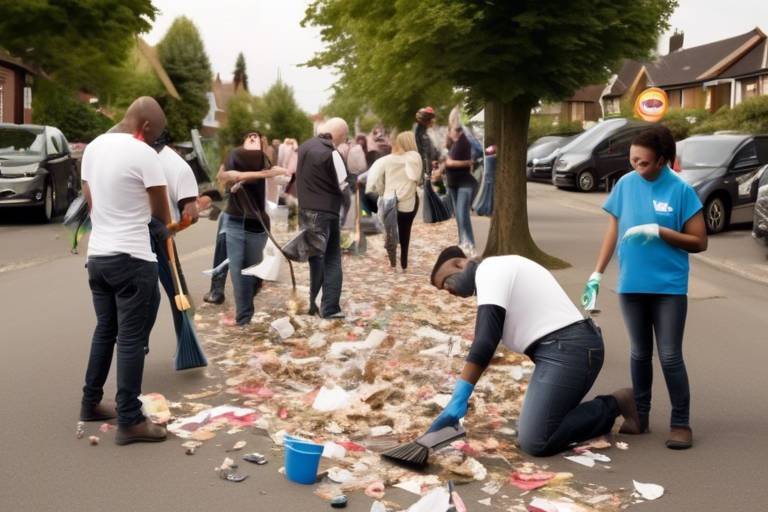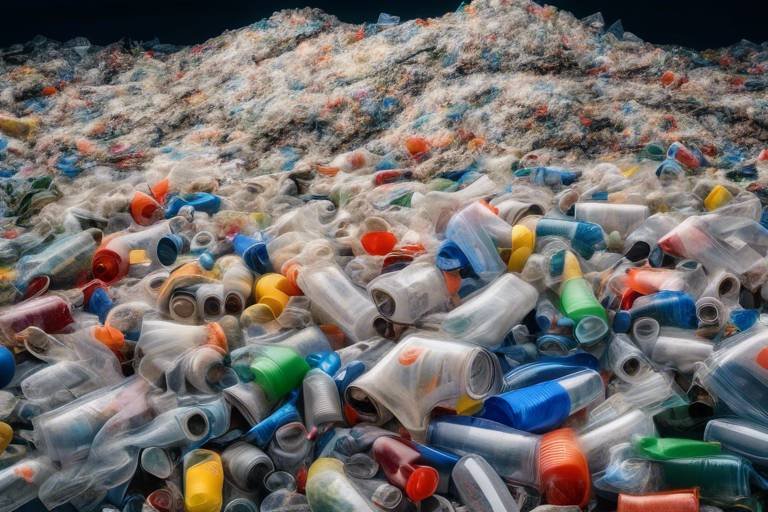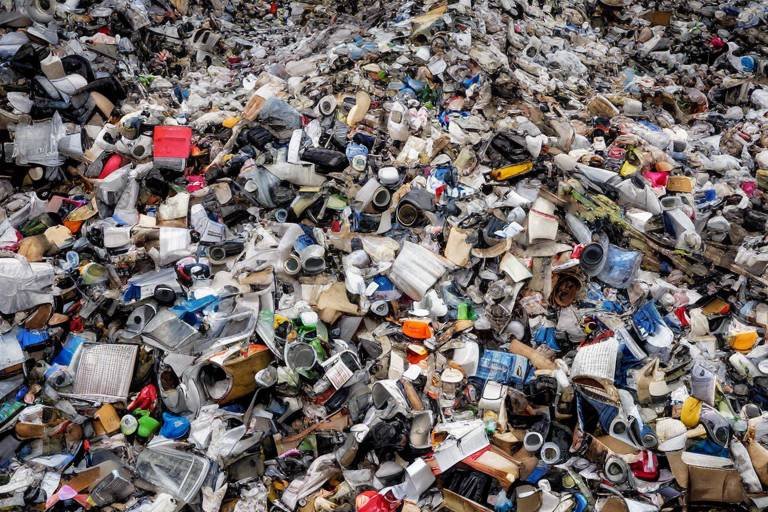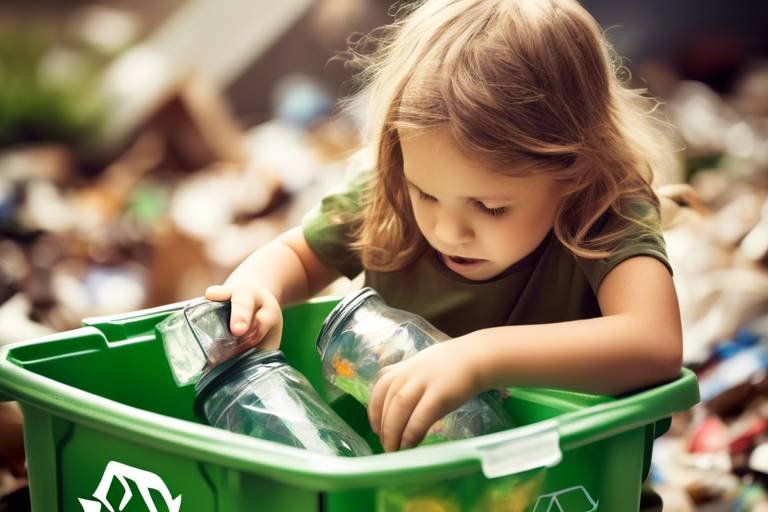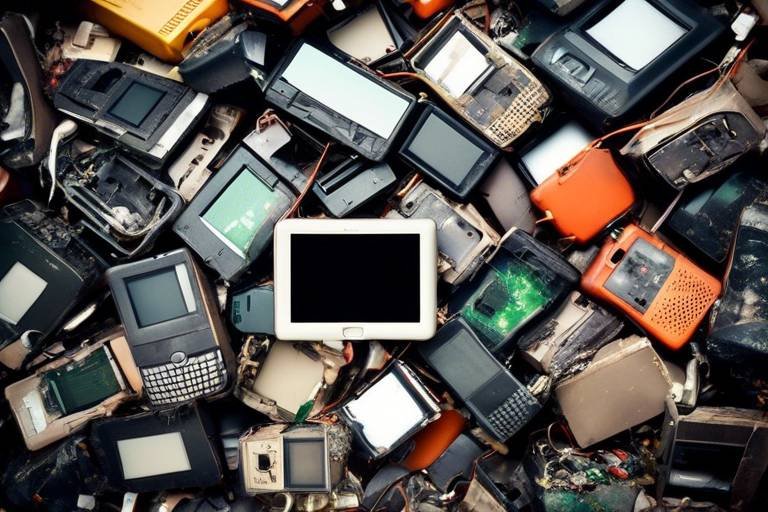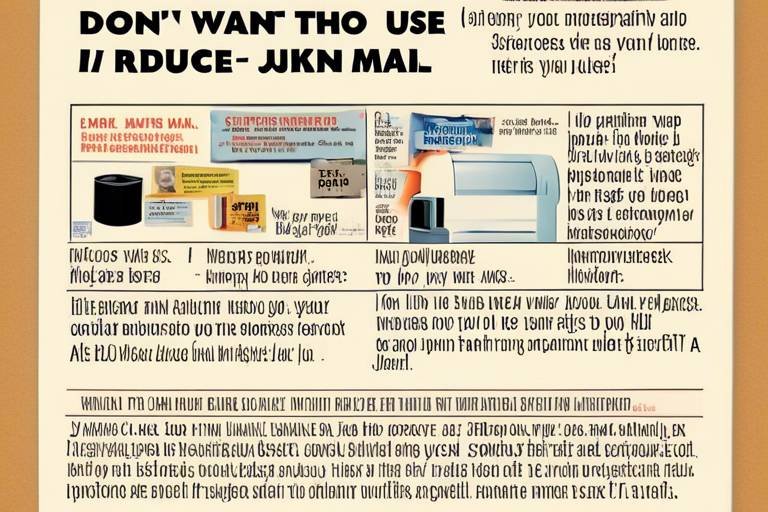The Importance of Ocean Clean-up Initiatives
Have you ever gazed out at the ocean and wondered about the hidden treasures beneath the waves? The vast blue expanse is not just a beautiful sight; it is a vital ecosystem that supports life on Earth. However, this beauty is marred by a dark reality—ocean pollution. The importance of ocean clean-up initiatives cannot be overstated, as they play a crucial role in protecting marine life, restoring ecosystems, and ensuring that future generations can enjoy the wonders of our oceans. Imagine a world where vibrant coral reefs flourish and marine animals thrive without the threat of plastic waste choking their habitats. This vision is achievable through dedicated clean-up efforts.
Ocean clean-up initiatives are not just about picking up trash; they represent a movement towards sustainability and environmental stewardship. As we dive deeper into this topic, we will explore the various aspects of ocean pollution, its impact on marine ecosystems, and the inspiring efforts being made globally to combat this pressing issue. It's a journey that reveals the interconnectedness of our actions and the health of our oceans.
Understanding the sources and consequences of ocean pollution is the first step in addressing this crisis. From plastic waste that takes centuries to decompose to chemical runoff from agriculture, the causes are diverse and often intertwined. The good news? With awareness and action, we can turn the tide. Clean-up initiatives not only remove debris but also educate communities about the importance of reducing waste at the source. This holistic approach is essential for long-term success.
As we navigate through the following sections, we will uncover the profound impact of pollution on marine life, including how microplastics infiltrate the food chain, and the community-driven efforts that amplify these clean-up campaigns. Together, we can foster a deeper understanding of our oceans and ignite a passion for their preservation. So, grab your diving gear—metaphorically speaking—and let’s plunge into the depths of ocean clean-up initiatives!

Understanding Ocean Pollution
Ocean pollution is not just a distant problem; it’s a pressing environmental crisis that affects every one of us. Imagine walking along a beach, only to find it littered with plastic bottles, bags, and other debris. This scene is becoming all too common, and it’s a stark reminder of how our actions on land have far-reaching consequences for our oceans. The sources of ocean pollution are diverse and alarming, including plastic waste, chemical runoff, and oil spills. Each of these contributors plays a significant role in the degradation of marine environments.
To tackle this issue effectively, we must first understand the various types of pollutants that invade our oceans. For instance, plastic waste is one of the most visible forms of pollution. It can take hundreds of years to decompose, and during that time, it breaks down into smaller pieces known as microplastics. These tiny particles are not only unsightly but also incredibly harmful to marine life. Another major contributor is chemical runoff, which includes pesticides and fertilizers that wash into the ocean from agricultural lands. This runoff can lead to harmful algal blooms, which deplete oxygen levels in the water and create dead zones where marine life cannot survive.
Oil spills, while less frequent, are catastrophic events that can devastate marine ecosystems. Just think about the infamous Deepwater Horizon spill in 2010, which released millions of gallons of oil into the Gulf of Mexico, affecting countless species and coastal communities. The aftermath of such spills can linger for decades, highlighting the urgent need for preventive measures and efficient clean-up strategies.
In addition to these major contributors, there are also other pollutants that often go unnoticed but can have severe impacts. For example, heavy metals like mercury and lead can enter the ocean through industrial discharges. These metals accumulate in marine organisms, posing risks not only to wildlife but also to human health when we consume contaminated seafood. The complexity of ocean pollution necessitates a multifaceted approach to understand its sources and effects fully.
To illustrate the impact of various pollutants on ocean health, consider the following table:
| Type of Pollution | Source | Impact on Marine Life |
|---|---|---|
| Plastic Waste | Consumer products, packaging | Ingestion, entanglement, habitat degradation |
| Chemical Runoff | Agricultural activities | Algal blooms, oxygen depletion |
| Oil Spills | Industrial accidents | Coastal habitat destruction, toxicity |
| Heavy Metals | Industrial discharges | Toxin accumulation in food chains |
Understanding ocean pollution is the first step toward effective clean-up initiatives. By recognizing the sources and impacts of these pollutants, we can better advocate for policies and practices that protect our oceans. Awareness is key, and it starts with each of us taking responsibility for our actions. Whether it’s reducing plastic consumption, supporting sustainable agriculture, or participating in local clean-up efforts, every little bit helps in the fight against ocean pollution.

Impact on Marine Life
The impact of ocean pollution on marine life is a profound issue that cannot be overlooked. Imagine a vibrant underwater world teeming with life, where fish dart through coral reefs and sea turtles glide gracefully through crystal-clear waters. Now, picture that same world choked with plastic debris, toxic chemicals, and oil spills. This stark contrast highlights the critical need for ocean clean-up initiatives. Pollution not only disrupts the natural beauty of our oceans but also poses a serious threat to the diverse marine ecosystems that rely on clean waters to thrive.
One of the most alarming consequences of ocean pollution is habitat destruction. Coral reefs, often referred to as the "rainforests of the sea," are particularly vulnerable. They provide shelter and food for countless marine species, but rising temperatures and pollution lead to coral bleaching and degradation. As these vital habitats decline, the species that depend on them face increased risks of extinction. The loss of biodiversity in our oceans is not just an environmental concern; it also impacts human communities that rely on fish and other marine resources for their livelihoods.
Moreover, pollution disrupts food chains, creating a domino effect that can lead to widespread ecological imbalance. For instance, when smaller fish ingest microplastics, they become toxic carriers of pollutants. These fish are then consumed by larger predators, including commercially important species like tuna and swordfish. The result? Toxins accumulate in the bodies of these larger fish, making them unsafe for human consumption. This bioaccumulation poses serious health risks not only to marine life but also to humans who rely on seafood as a primary source of protein.
To better understand the impact of pollution on marine life, consider the following table that outlines some key effects:
| Type of Pollution | Impact on Marine Life |
|---|---|
| Plastic Waste | Ingestion and entanglement, leading to injury and death |
| Chemical Runoff | Habitat degradation and bioaccumulation of toxins |
| Oil Spills | Coating of marine organisms, affecting breathing and reproduction |
As we delve deeper into the issue, it's essential to recognize that the health of our oceans directly impacts the health of our planet. The interconnectedness of ecosystems means that pollution in one area can ripple through the entire marine environment. Thus, clean-up initiatives are not just about removing debris; they are about restoring balance to our oceans and ensuring the survival of marine species.
In conclusion, the impact of ocean pollution on marine life is both immediate and far-reaching. From habitat destruction to disrupted food chains, the consequences are dire. However, by supporting clean-up initiatives and advocating for sustainable practices, we can work together to protect our oceans and the incredible life they harbor. The responsibility lies with each of us to take action, whether it’s participating in local clean-up events or making conscious choices in our daily lives that reduce our plastic footprint.
- What are the main sources of ocean pollution?
Ocean pollution primarily comes from plastic waste, chemical runoff from agriculture, sewage discharge, and oil spills. - How does pollution affect human health?
Pollution in oceans can lead to the bioaccumulation of toxins in seafood, which can pose health risks to humans consuming contaminated fish. - What can individuals do to help reduce ocean pollution?
Individuals can reduce ocean pollution by minimizing plastic use, participating in beach clean-ups, and supporting policies aimed at protecting marine environments.

Microplastics and Their Effects
Microplastics are tiny plastic particles less than 5mm in size, and they have become a significant concern in our oceans. These microscopic invaders originate from various sources, including the breakdown of larger plastic items, synthetic fibers from clothing, and even personal care products like exfoliating scrubs. Can you imagine the sheer volume of these particles swirling in our oceans? Estimates suggest that there are trillions of microplastic particles in the ocean, and their impact on marine ecosystems is nothing short of alarming.
One of the most critical effects of microplastics is their ability to be ingested by marine organisms. Imagine a small fish mistaking a microplastic for food; this is happening every day in our oceans. Once ingested, these particles can cause physical harm, blockages, and even death. More troubling is the fact that microplastics can carry harmful chemicals and toxins, which can leach into the organisms that consume them. This creates a ripple effect throughout the food chain, affecting not just marine life but also humans who consume seafood.
Research has shown that microplastics can accumulate in the tissues of marine animals, leading to a phenomenon known as bioaccumulation. As smaller fish eat microplastics, larger predators, including species like tuna and swordfish, consume these smaller fish, leading to higher concentrations of toxins in their bodies. This cycle raises serious health concerns for humans who eat seafood, as the toxins can lead to various health issues, including hormonal disruptions and potential carcinogenic effects.
To illustrate the severity of the issue, consider the following table that outlines the types of marine organisms affected by microplastics and their potential consequences:
| Marine Organism | Potential Effects |
|---|---|
| Plankton | Disruption of growth and reproduction |
| Fish | Physical harm, reduced feeding, and growth |
| Sea Turtles | Intestinal blockage and malnutrition |
| Seabirds | Ingestion leading to starvation and death |
So, what can we do about this pressing issue? Tackling microplastic pollution requires a multifaceted approach. Awareness is key—educating ourselves and others about the sources and impacts of microplastics can drive change. Additionally, supporting legislation aimed at reducing plastic use and promoting alternative materials is crucial. Innovations in clean-up technologies, such as specialized nets and filtration systems, are also being developed to remove microplastics from our waters.
In conclusion, microplastics are not just a minor inconvenience; they represent a major threat to marine ecosystems and human health. By understanding their effects and taking action, we can help protect our oceans for future generations. The time to act is now—let's make waves in the fight against ocean pollution!
- What are microplastics? Microplastics are small plastic particles less than 5mm in size that originate from various sources, including the breakdown of larger plastics.
- How do microplastics affect marine life? Marine organisms can ingest microplastics, leading to physical harm and the accumulation of toxins in their bodies, which can then affect predators and humans.
- What can be done to reduce microplastic pollution? Reducing plastic use, supporting legislation for alternative materials, and using innovative clean-up technologies are essential steps in combating microplastic pollution.

Bioaccumulation in Food Chains
Bioaccumulation is a fascinating yet alarming phenomenon that occurs when toxins, such as those found in microplastics, accumulate in the bodies of living organisms over time. This process is particularly concerning in marine environments, where numerous species, from tiny plankton to large fish, can inadvertently ingest these harmful substances. Imagine a tiny fish swimming in a sea of plastic particles, unknowingly consuming toxins that will eventually make their way up the food chain. As larger predators, including humans, feast on these smaller fish, they too become victims of bioaccumulation, leading to serious health risks.
The implications of bioaccumulation extend far beyond marine life. When toxins accumulate in the bodies of fish, they can reach levels that pose significant health risks to humans who consume seafood. Research has shown that certain contaminants can lead to a range of health issues, including neurological disorders, reproductive problems, and even cancer. This is particularly alarming for populations that rely heavily on seafood as a primary source of nutrition.
To illustrate the process of bioaccumulation, consider the following table that outlines how toxins move through a food chain:
| Level in Food Chain | Organisms Involved | Potential Toxins Accumulated |
|---|---|---|
| 1st Level | Phytoplankton | Microplastics, Heavy Metals |
| 2nd Level | Zooplankton | Concentrated Heavy Metals |
| 3rd Level | Small Fish | PCBs, DDT |
| 4th Level | Larger Fish (e.g., Tuna) | Mercury, Other Toxins |
| 5th Level | Humans | Health Risks from Consumed Fish |
This table highlights the gradual increase of toxins as they move up the food chain, illustrating just how interconnected our ecosystems are. Each organism plays a critical role, and the health of one directly impacts the health of others. As a result, addressing the issue of plastic pollution and its resultant toxins is not merely an environmental concern; it’s a public health imperative.
To combat the dangers of bioaccumulation, it is essential to implement comprehensive clean-up initiatives and advocate for policies that reduce plastic production and waste. By understanding the pathways of toxins through food chains, we can begin to appreciate the urgency of ocean clean-up efforts and their role in protecting not only marine ecosystems but also human health.
- What is bioaccumulation? Bioaccumulation refers to the process where harmful substances accumulate in an organism's body over time, leading to increased concentrations of toxins as they move up the food chain.
- How does microplastic pollution affect humans? Microplastics can accumulate in seafood consumed by humans, potentially leading to various health risks, including neurological disorders and reproductive issues.
- What can be done to reduce ocean pollution? Effective strategies include reducing plastic use, supporting clean-up initiatives, and advocating for policies that limit plastic production and promote recycling.

Strategies to Combat Microplastics
Microplastics, those tiny plastic particles less than 5mm in size, are wreaking havoc on our oceans and the creatures that inhabit them. To tackle this insidious problem, a multi-faceted approach is essential. It's not just about picking up plastic from the beaches; we need to get to the root of the issue. So, what can we do to combat microplastics effectively? Let's dive into some innovative strategies that are making waves in the fight against this pollution.
First and foremost, policy changes are crucial. Governments worldwide are beginning to recognize the seriousness of microplastic pollution and are implementing regulations to limit plastic production and usage. For instance, bans on single-use plastics and incentives for biodegradable alternatives are gaining traction. These policies not only aim to reduce the amount of plastic entering our oceans but also encourage companies to innovate and find sustainable solutions.
Another effective strategy is public awareness campaigns. Educating the masses about the dangers of microplastics is vital. When people understand how their daily choices contribute to ocean pollution, they are more likely to make changes. Community workshops, social media campaigns, and school programs can significantly increase awareness. Imagine a world where everyone knows the impact of their plastic consumption—what a difference that would make!
Moreover, technological advancements are paving the way for innovative clean-up solutions. For example, researchers are developing advanced filtration systems that can capture microplastics from wastewater before they enter our oceans. These systems are being installed in treatment plants and are proving to be effective. Additionally, organizations are experimenting with drone technology and autonomous boats equipped with nets designed to catch microplastics in the water. This combination of human ingenuity and technology could revolutionize how we deal with ocean pollution.
Lastly, community involvement is a game-changer. Local clean-up initiatives not only help remove existing microplastics but also foster a sense of responsibility among participants. When communities come together for beach clean-ups or river clean-ups, they create a ripple effect—encouraging others to join the fight and raising awareness about the importance of keeping our oceans clean. The more people involved, the greater the impact!
In summary, combating microplastics requires a holistic approach that includes policy changes, public awareness, technological innovations, and community engagement. Each strategy plays a vital role in reducing the amount of plastic that ends up in our oceans. It’s a daunting challenge, but with collective effort and commitment, we can turn the tide against microplastic pollution.
Q1: What are microplastics, and where do they come from?
A1: Microplastics are small plastic particles less than 5mm in size, originating from larger plastic items that break down over time, as well as from synthetic fibers shed during washing clothes and microbeads found in personal care products.
Q2: How do microplastics affect marine life?
A2: Marine organisms can ingest microplastics, leading to physical harm, toxic exposure, and bioaccumulation of harmful substances in the food chain, ultimately affecting both marine life and human health.
Q3: What can individuals do to help reduce microplastic pollution?
A3: Individuals can reduce microplastic pollution by minimizing plastic use, participating in clean-up efforts, supporting legislation aimed at reducing plastic production, and spreading awareness about the issue.
Q4: Are there any organizations focused on combating microplastics?
A4: Yes, numerous organizations are dedicated to combating microplastics, including The Ocean Cleanup, Plastic Pollution Coalition, and Surfrider Foundation, each working on various initiatives to tackle this pressing issue.

Community Involvement in Clean-up Efforts
When it comes to tackling the enormous challenge of ocean pollution, the role of the community cannot be overstated. Imagine a world where every beach, river, and oceanfront is pristine, free from the clutches of plastic waste and chemical runoff. This dream is not as far-fetched as it may seem, thanks to the tireless efforts of local communities around the globe. Community involvement in clean-up initiatives is like the spark that ignites a larger fire of environmental awareness and action. When individuals come together, they can create a ripple effect that inspires others to join the cause.
One of the most powerful aspects of community clean-up efforts is their ability to foster a sense of ownership and responsibility towards the environment. When people actively participate in cleaning up their local beaches or parks, they develop a deeper connection to these natural spaces. This connection often translates into a more profound commitment to protecting them. Moreover, engaging in these activities can be incredibly rewarding; it not only helps the environment but also builds community bonds and promotes teamwork.
For instance, consider the impact of organized beach clean-up events. These gatherings often draw volunteers from all walks of life, united by a common goal. Participants can be seen laughing, sharing stories, and working side by side, all while collecting trash and debris that would otherwise harm marine life. Such events not only result in cleaner beaches but also serve as educational opportunities. Volunteers often leave with a better understanding of the issues facing our oceans and the steps they can take to mitigate them.
Furthermore, community involvement can take many forms, from local clean-up days to educational workshops on waste reduction. Here are a few ways communities can engage:
- Organizing Regular Clean-Up Drives: Setting up monthly or quarterly clean-up events can help maintain local natural areas and encourage ongoing participation.
- Hosting Educational Workshops: Teaching community members about the effects of pollution and how to minimize waste can empower individuals to make more environmentally friendly choices.
- Collaborating with Local Businesses: Partnering with local businesses for sponsorships or resources can enhance the reach and impact of clean-up initiatives.
Moreover, social media plays a crucial role in rallying community support. Platforms like Instagram and Facebook allow organizers to share their events widely, attract volunteers, and highlight the importance of their mission. A single post can inspire dozens of people to join in, proving that digital engagement can lead to real-world action.
In conclusion, community involvement is not just beneficial; it is essential for the success of ocean clean-up efforts. When individuals come together, they can create significant environmental change. As more people recognize the importance of their actions, we can hope for a future where our oceans are clean and vibrant. The journey may be long, but with community spirit and dedication, we can make waves of positive change in our oceans.
Q: How can I get involved in local ocean clean-up efforts?
A: You can start by researching local organizations that focus on environmental clean-up. Many of them host regular events where volunteers are always welcome.
Q: What should I bring to a clean-up event?
A: It’s advisable to bring gloves, reusable bags, and water to stay hydrated. Some events may provide supplies, but it’s always good to check beforehand.
Q: Are there any age restrictions for participating in clean-up efforts?
A: Most clean-up events welcome participants of all ages, but it's best to check with the organizers for any specific guidelines or recommendations.
Q: How do clean-up initiatives benefit marine life?
A: Clean-up initiatives help remove harmful debris from the ocean, reducing the risk of entanglement and ingestion by marine animals, thus promoting healthier ecosystems.

Global Clean-up Initiatives
As the world grapples with the growing menace of ocean pollution, various have emerged, uniting communities, organizations, and governments in a common cause. These initiatives are not just about picking up trash; they represent a collective effort to restore the beauty and health of our oceans. Imagine a world where our beaches are pristine, marine life thrives, and the waters are free from harmful pollutants. This vision drives countless individuals and groups to take action.
One of the most notable movements is the Ocean Conservancy's International Coastal Cleanup, which has mobilized millions of volunteers since its inception. Every year, people from all walks of life come together to clean coastlines, gathering data on the types of debris found. This data is crucial as it helps identify the sources of pollution and informs policy changes aimed at reducing waste at the source. In 2022 alone, volunteers removed over 16 million pounds of trash from coastlines across the globe, a testament to the power of community involvement.
Another significant initiative is the Great Pacific Garbage Patch Cleanup, spearheaded by The Ocean Cleanup organization. This ambitious project aims to tackle the massive accumulation of plastic debris in the Pacific Ocean. Using innovative technologies, such as floating barriers and autonomous vessels, The Ocean Cleanup is working to extract millions of tons of plastic from the ocean. Their efforts not only focus on clean-up but also on preventing future pollution through education and advocacy.
Across the globe, local initiatives also play a vital role in ocean clean-up efforts. For instance, many coastal towns have established beach clean-up days, where residents gather to clean their local shores. These events foster a sense of community and raise awareness about the importance of keeping our oceans clean. The impact of these local efforts can be profound, as they often lead to lasting changes in behavior and policy at the municipal level.
To further illustrate the global scope of these initiatives, consider the following table that highlights some key organizations and their missions:
| Organization | Mission | Achievements |
|---|---|---|
| Ocean Conservancy | Mobilizing volunteers for coastal clean-ups and advocating for policy change. | Over 16 million pounds of trash removed in 2022. |
| The Ocean Cleanup | Developing technologies to remove plastic from oceans and prevent future pollution. | Plans to remove 90% of floating ocean plastic by 2040. |
| Surfrider Foundation | Protecting oceans and beaches through grassroots activism. | Thousands of beach clean-ups and advocacy campaigns. |
These initiatives not only aim to clean our oceans but also to educate the public about the importance of sustainable practices. They encourage individuals to reduce their plastic consumption and advocate for policies that protect marine ecosystems. The ripple effect of these efforts can lead to significant changes in consumer behavior and corporate responsibility.
In conclusion, the fight against ocean pollution is a global endeavor that requires the participation of everyone. From large organizations to local communities, every effort counts in restoring the health of our oceans. By supporting and participating in these clean-up initiatives, we can all contribute to a cleaner, healthier planet for future generations. So, are you ready to roll up your sleeves and join the movement?
- What are ocean clean-up initiatives? These are organized efforts aimed at removing debris and pollutants from the ocean and coastal areas.
- How can I get involved? You can participate in local clean-up events, support organizations working on ocean conservation, or advocate for policies that reduce pollution.
- What impact do these initiatives have? They help restore marine ecosystems, protect wildlife, and raise awareness about the importance of ocean health.

Notable Organizations and Their Missions
When it comes to tackling the daunting challenge of ocean pollution, several notable organizations are leading the charge, each with a unique mission and approach. These organizations are not just fighting the good fight; they are paving the way for a cleaner, healthier ocean for future generations. One such organization is Ocean Conservancy, which focuses on creating science-based solutions to protect the ocean from pollution and overfishing. Their annual International Coastal Cleanup event brings together thousands of volunteers to clean up beaches and waterways, raising awareness about the impact of litter on marine life.
Another powerful player in this arena is the Ocean Cleanup Project, which has developed innovative technology to remove plastic from the ocean. Their mission is straightforward yet ambitious: to rid the oceans of plastic waste using a passive drifting system that captures debris while allowing marine life to pass unharmed. This organization exemplifies how innovation can play a crucial role in environmental conservation.
In addition to these organizations, Surfrider Foundation stands out for its community-driven approach. With a mission to protect the world’s oceans, waves, and beaches, Surfrider engages local communities in advocacy, education, and beach clean-ups. Their grassroots efforts empower individuals to take action and make a difference in their local environments, proving that collective action can lead to significant improvements.
Moreover, organizations like Plastic Pollution Coalition focus on raising awareness about the pervasive issue of plastic pollution. They work towards reducing plastic consumption and promoting sustainable alternatives. Their initiatives include educational campaigns, policy advocacy, and community engagement, all aimed at fostering a culture of sustainability.
To give you a clearer picture of these organizations and their missions, here’s a brief overview in table format:
| Organization | Mission | Key Initiatives |
|---|---|---|
| Ocean Conservancy | Protecting the ocean through science-based solutions. | International Coastal Cleanup, Policy Advocacy |
| Ocean Cleanup Project | Removing plastic from the ocean using innovative technology. | Passive drifting systems, Research and Development |
| Surfrider Foundation | Protecting oceans, waves, and beaches through grassroots activism. | Beach clean-ups, Advocacy, Education |
| Plastic Pollution Coalition | Raising awareness and reducing plastic pollution. | Educational campaigns, Community engagement |
These organizations exemplify the power of collaboration and innovation in the fight against ocean pollution. By harnessing the collective efforts of individuals, communities, and technology, they are making strides toward a cleaner, healthier ocean. It is essential for us all to support these initiatives, whether through volunteering, donating, or simply spreading the word about the importance of ocean conservation.
Q1: How can I get involved in ocean clean-up initiatives?
A1: There are many ways to get involved! You can participate in local beach clean-ups, volunteer with organizations like Surfrider Foundation, or even start your own initiative in your community.
Q2: What can I do to reduce plastic pollution in my daily life?
A2: You can reduce plastic pollution by using reusable bags, bottles, and containers, avoiding single-use plastics, and supporting businesses that prioritize sustainability.
Q3: Are there any technological advancements in ocean clean-up?
A3: Yes! Organizations like the Ocean Cleanup Project are using innovative technologies, such as passive drifting systems, to effectively capture plastic waste without harming marine life.
Q4: Why is it important to protect marine ecosystems?
A4: Protecting marine ecosystems is crucial for biodiversity, the health of our planet, and the livelihoods of millions of people who depend on the ocean for food, recreation, and economic activities.

Innovative Technologies in Clean-up
As the world grapples with the dire consequences of ocean pollution, innovative technologies are stepping up to the plate, transforming the way we approach clean-up efforts. Imagine a future where the oceans are not only free from debris but also thriving with life. This vision is becoming a reality thanks to groundbreaking advancements in technology that are designed to tackle pollution head-on.
One of the most exciting developments in ocean clean-up technology is the use of autonomous drones. These drones are equipped with advanced sensors and imaging technology, allowing them to scan vast areas of ocean for debris. They can identify hotspots of pollution and help direct clean-up crews to the most affected areas. Picture a fleet of these drones working tirelessly, like a swarm of bees, efficiently gathering data and reporting back to their human counterparts.
Another game-changer is the emergence of floating booms and barriers. These are large structures designed to contain and collect debris, particularly in areas where plastic waste tends to accumulate, such as in gyres. By acting as a net, these booms can trap waste while allowing marine life to pass beneath them unharmed. The collected debris can then be removed and processed, significantly reducing pollution levels. It’s like setting up a giant vacuum cleaner in the ocean, sucking up all the unwanted waste!
Furthermore, innovative technologies like biodegradable materials are being developed to replace conventional plastics. These materials can break down naturally in marine environments, reducing the long-term impact of waste. Imagine a world where the products we use do not contribute to pollution but instead dissolve harmlessly back into the ecosystem. This shift is crucial in preventing future pollution before it even starts.
In addition to these technologies, robotic systems are also being deployed for underwater clean-up missions. These robots can dive deep into the ocean, reaching areas that are otherwise inaccessible to human divers. Equipped with specialized tools, they can collect debris, assess environmental damage, and even monitor the health of marine habitats. It’s like sending in a superhero to rescue the ocean from the clutches of pollution!
To give you a clearer picture of the impact of these technologies, consider the following table that highlights some of the key innovations and their contributions to ocean clean-up efforts:
| Technology | Description | Impact |
|---|---|---|
| Autonomous Drones | Equipped with sensors to identify pollution hotspots. | Increased efficiency in locating and targeting clean-up areas. |
| Floating Booms | Structures that contain and collect debris. | Significantly reduces plastic waste in key areas. |
| Biodegradable Materials | Materials that break down naturally in the ocean. | Prevents future pollution by reducing reliance on traditional plastics. |
| Robotic Systems | Underwater robots that collect debris and monitor habitats. | Access to hard-to-reach areas and real-time environmental data. |
As these technologies continue to evolve, they hold the potential to revolutionize our approach to ocean clean-up. The combination of human ingenuity and technological innovation can create a cleaner, healthier ocean for future generations. However, it’s essential to complement these advancements with community engagement and policy changes to ensure sustainable practices. After all, technology is only as effective as the people who wield it!
- What are microplastics? Microplastics are tiny plastic particles less than 5mm in size that can harm marine life and enter the food chain.
- How do autonomous drones help in ocean clean-up? They scan large areas for pollution, identify hotspots, and guide clean-up crews to targeted locations.
- What role do communities play in ocean clean-up? Community involvement is crucial for raising awareness, organizing clean-up events, and supporting sustainable practices.
- Are biodegradable materials effective in reducing ocean pollution? Yes, they break down naturally, reducing the long-term impact of plastic waste in marine environments.
Frequently Asked Questions
- What is ocean pollution and what causes it?
Ocean pollution refers to the introduction of harmful substances into the ocean, resulting in detrimental effects on marine ecosystems. Major causes include plastic waste, chemical runoff from agriculture, oil spills, and untreated sewage. It's a complex issue that requires a multifaceted approach to tackle effectively.
- How does ocean pollution affect marine life?
Marine life suffers greatly due to pollution. It can lead to habitat destruction, endangerment of species, and disrupted food chains. For instance, when larger animals ingest plastic, it can cause internal injuries or death. Additionally, toxins from polluted waters can accumulate in smaller organisms, magnifying the impact as these toxins move up the food chain.
- What are microplastics and why are they a concern?
Microplastics are tiny plastic particles less than five millimeters in size, often resulting from the breakdown of larger plastic items. They pose a significant threat to marine organisms as they can be ingested, leading to physical harm and potential transfer of toxins into the food chain. This not only affects marine life but also poses risks to human health through seafood consumption.
- What is bioaccumulation and how does it relate to ocean pollution?
Bioaccumulation occurs when toxins build up in an organism over time, often through the consumption of contaminated food. In the context of ocean pollution, as smaller marine organisms ingest microplastics and toxins, these harmful substances can concentrate in larger predators, including fish that humans eat, leading to health risks for us.
- What strategies can help reduce microplastic pollution?
To combat microplastic pollution, several strategies can be implemented, including stricter regulations on plastic production, improved waste management practices, and public awareness campaigns. Innovative clean-up technologies, such as specialized nets and filtration systems, are also being developed to remove microplastics from water bodies.
- How can communities get involved in ocean clean-up efforts?
Community involvement is essential for the success of ocean clean-up initiatives. Local groups can organize beach clean-ups, educate the public about the impacts of pollution, and advocate for policy changes. Engaging with schools and local businesses can also foster a culture of environmental stewardship and responsibility.
- What are some notable global clean-up initiatives?
Several organizations are making significant strides in ocean clean-up efforts. Notable initiatives include The Ocean Cleanup, which focuses on removing plastic from the Great Pacific Garbage Patch, and Surfrider Foundation, which advocates for clean beaches and ocean protection. These organizations not only clean up but also raise awareness about the importance of maintaining healthy oceans.
- What innovative technologies are being used in ocean clean-up?
Innovative technologies play a crucial role in enhancing the efficiency of ocean clean-up operations. Examples include autonomous drones for monitoring pollution, specialized boats equipped with nets to capture debris, and advanced filtering systems that can trap microplastics. These tools are revolutionizing the way we approach ocean conservation.


